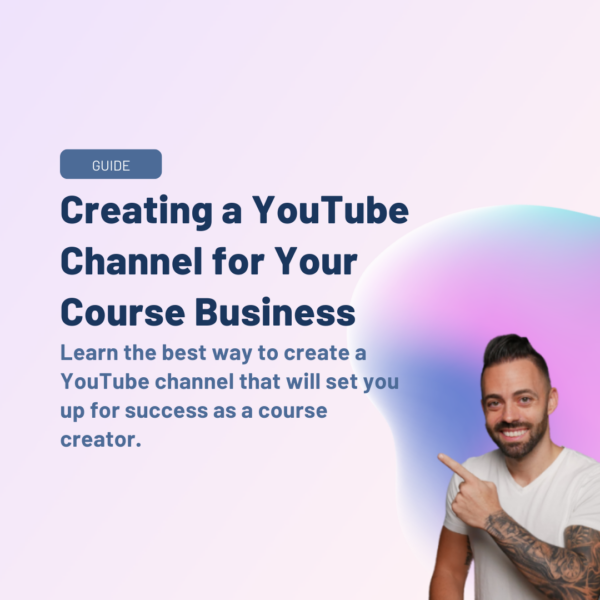Having your course ready to go is step one… but then what? Building your online course is only half the battle; getting your course in front of people so they’ll purchase is the other half, and deserves a lot of time and attention.
There are many ways to get your first online course sale, but there are a few common tips and tricks that we’ve seen work well time and time again. Let’s dive in!
1. Build up hype
The best time to start telling people about your course is before it launches. This is the right time to start telling your audience what you’re up to, and to get the gears in motion for a pre-sales campaign. Offer up the first chapter or a small sample of what you’ve got in the works, and give your nearest and dearest (ie: your existing list) a tempting offer to jump in site unseen. Check out this past blog post all about building hype.
The best time to start selling your online course is before it's available. Click To TweetDon’t have a list built? You probably have one and just don’t know it. Your existing contacts are a great place to start, as these are the people who are already interested and engaged in what you are doing, so it’s a great time to reach out.
2. Make new friends
Participating in online communities can be a great way to expand your audience. In any niche, you are bound to find large groups of people who would welcome a new, knowledgeable participant interested in the same things they are. Some great places to look for communities include:
- LinkedIn Groups
- Facebook Groups
- Google+ Communities
- Twitter Chats
If you haven’t heard of Twitter chats, these are a great way to dive into connecting on this social platform. Twitter chats are group conversations that are connected via hashtags, and are a perfect way to meet new people in your niche. My favorite listings of twitter chats are https://twitter.com/chatsalad and http://tweetreports.com/twitter-chat-schedule/. Our friends over at Buffer also have a great post up all about these events.
You found a group, but what now?
When considering etiquette in new communities, I like to equate online communities to their in-person equivalent. If I’m walking into a networking event for the first time and start shouting “BUY MY STUFF!”, I’m probably going to get a security escort out the door.
Walk into the room screaming BUY THIS and security will escort you out. The same rules apply online. Click To TweetIf, instead, I find a friendly bunch engaged in conversation and join in (adding some valuable points along the way), I’m going to have a much better time. Communities aren’t a one visit proposition – but if you find some groups that are in your niche and that you can really add value to, you’ll find this can go a long way in building your audience organically.
3. Gather social proof
Testimonials are a valuable way to instill confidence in potential purchasers. If they can see written feedback by past students, they are more likely to buy.
If you’ve taught before, perfect! Pulling out reviews you’ve received as a teacher (even if written for other material) is helpful here. There is also value in getting your course content into a few hands early, to capture fresh reviews before going live with your launch.
If you have a course that caters to a specific group, getting it into the hands of people who are known in your space can do wonders. If you can get a personal review or recommendation from someone who is respected in your niche (and even better, if they’re willing to share the link out, perhaps with a bonus affiliate cut?) that’s a great kickoff.
Always give more than you're asking for. Click To TweetJust remember – when reaching out always give more than you’re asking for, and you’ll be in good form.
4. Get offline
There’s nothing quite like being face to face with someone to not only introduce them to your course but to also build a genuine relationship along the way.
If you can teach about a topic, you can speak to a group about it. Check Meetup.com and other event sites in your area to find groups who are already getting together who might be interested in what you are teaching. Groups are often looking for speakers for their events, and if you can get in front of a group of new-to-you people to share what you know about a topic that interests them, you’ll likely find that this translates into a few sales, too.
If speaking isn’t your thing, attend for the face to face connections. And, of course, if you can’t find a meetup that suits you, start your own! Inviting people out to connect over a common topic is a great way to find and build your tribe.
Even when you sell online, getting face to face with your audience is vital. Click To TweetHere at Thinkific, we love to get out to speak to local groups and events. Having a face to face connection with our local customers is really valuable, and we love the opportunity to put some faces to names! In-person relationships are also great when you want to ask the tough questions about where you can improve, or if you need a guinea pig for a new module. The perfect opportunity to call up a new friend!
5. Give it away
Offering webinars with valuable must-have content to your target audience can be a great way for them to get to know you – and if you deliver on what you’ve offered for free, they’re more likely to purchase seconds.
Webinars are particularly beneficial because they’re a way to connect directly with your audience, where folks can ask questions and get answers in real-time. I love the community aspect of these events and find them more valuable at times than something like a pre-recorded training video, which doesn’t have the same personal experience.
Webinars also benefit from being a fixed point in time, and specific timelines are perfect for beating audience procrastination!
Now it’s your turn!
These are just the tip of the iceberg as there are so many ways to get out there, but I wanted to share these specific tips not only because they work, but because I can’t stress enough the value of building relationships and connecting with people!
The added benefit of finding students this way is that they are MUCH more likely to be really engaged, and to refer you to their friends and their own networks when they know and trust you due to the relationship you’ve built.






